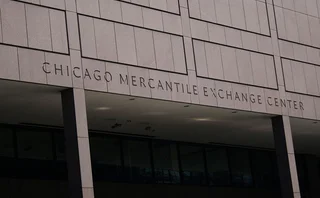
Trading volumes surge as Lehman clients rehedge
Some dealers have reported a surge in business in the wake of the bankruptcy of Lehman Brothers, as former clients of the failed investment bank look for new counterparties to replace hedges.
"We are seeing more and more enquiries. Clients had hedges with Lehman Brothers and they need to replace them," said one London-based head of exotic interest rates trading, speaking on September 17. "We've been swamped over the past few days and seen hundreds of trades on the exotic side."
One head of investment banking at a global bank agrees: "It was the best week ever for us in terms of client business. We saw a huge amount of flow from people rehedging positions."
Ninety-nine borrowers have outstanding structured notes and private placements that had been issued through Lehman, including the Republic of Italy, KfW and Freddie Mac, according to mtn-i, a data provider that covers the global medium-term note market. The bank's collapse would have left many of those issuers with unhedged exposures and in desperate need of new swap counterparties.
Lehman acted as dealer on $48.6 billion of outstanding structured notes and private placements, with structured notes accounting for $30.5 billion of that total, mtn-i states.
The inflation market, in particular, has seen heavy flows as former Lehman clients look to replace hedges on inflation-linked structures. David Slater, head of inflation trading, Europe and Asia, at BNP Paribas in London, says business volumes tripled in the weeks following Lehman's collapse.
"We've seen a mix of business, from structured products and Euribor capped at inflation notes, to the day-to-day medium-term notes, to asset swaps and some of the long-dated retail price index (RPI) business Lehman did," he says.
Sterling 30-year RPI swaps initially jumped by 10bp, from 3.9% on September 12 to 4% on September 15, partly amid concerns the loss of Lehman may put further strain on the UK inflation market. By September 29, RPI swaps were trading at 3.98%, according to BNP Paribas. The UK market has been under pressure for much of this year as utility firms and private finance initiatives, the largest issuers of inflation-linked debt in recent years, have withdrawn in response to the credit crisis, causing liquidity to dry up.
While inflation desks have seen increased flows on the back of the Lehman collapse, activity goes far beyond this sector, with dealers reporting enquiries across asset classes and from a broad variety of clients.
"We've seen some equity derivatives clients with whom we lost competitive bids to Lehman come back to the market. We've also seen some new business in the US from large US institutional clients looking for replacement hedges," says a London-based head of equity derivatives.
Some dealers also claim they are seeing flows from clients keen to shift from other investment bank counterparties. With questions being asked about the sustainability of the investment banking model following the collapse of Bear Stearns and Lehman, end-users increasingly prefer to trade with banks that have strong balance sheets and access to retail deposits, assert some participants.
"I would guess 80% of the rehedging is split between just five or six banks," says the head of investment banking. "We're also seeing some customers wanting to shift away from counterparties they feel pose too much risk."
Nick Sawyer.
Only users who have a paid subscription or are part of a corporate subscription are able to print or copy content.
To access these options, along with all other subscription benefits, please contact info@risk.net or view our subscription options here: http://subscriptions.risk.net/subscribe
You are currently unable to print this content. Please contact info@risk.net to find out more.
You are currently unable to copy this content. Please contact info@risk.net to find out more.
Copyright Infopro Digital Limited. All rights reserved.
As outlined in our terms and conditions, https://www.infopro-digital.com/terms-and-conditions/subscriptions/ (point 2.4), printing is limited to a single copy.
If you would like to purchase additional rights please email info@risk.net
Copyright Infopro Digital Limited. All rights reserved.
You may share this content using our article tools. As outlined in our terms and conditions, https://www.infopro-digital.com/terms-and-conditions/subscriptions/ (clause 2.4), an Authorised User may only make one copy of the materials for their own personal use. You must also comply with the restrictions in clause 2.5.
If you would like to purchase additional rights please email info@risk.net
More on Interest rate markets
New benchmark to give Philippine peso swaps a fillip, post-Isda add
Isda to include new PHP overnight rate and Indonesia’s Indonia in its next definitions update
SABR convexity adjustment for an arithmetic average RFR swap
A model-independent convexity adjustment for interest rate swaps is introduced
NatWest Securities US Treasury trading head departs
Jason Sable joined the UK bank in January 2022 from BNP Paribas
CME in talks to clear term SOFR basis swaps
US clearing house has held discussions with some dealers about clearing term SOFR-SOFR packages
Risky caplet pricing with backward-looking rates
The Hull-White model for short rates is extended to include compounded rates and credit risk
The curious case of backward short rates
A discretisation approach for both backward- and forward-looking interest rate derivatives is proposed
Cross-currency swaps will use RFRs on both legs, says JP exec
Despite slow start, all-RFR swaps will become the market standard within a year, according to Tom Prickett
June mid-month auctions – Coupon and yield trends
As Treasury issuance amounts set new records, coupons at the front end of the curve have marched downward, while back-end coupons have lagged. Yield spreads across each popular measure show a consistent steepening of the curve through the first half of…







